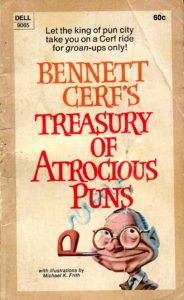Who knows Bennett Cerf any more? I’d guess that out a 100 randomly picked men and women on the street, the number who did would be a small scattering, if that. Even people my age wouldn’t really have much of a clue, despite United States v. One Book Called Ulysses, which ought to (does?) come up in school.
 I might not know much about him myself except for a paperback we had around the house when I was growing up: Bennett Cerf’s Treasury of Atrocious Puns. It was published in 1968, toward the end of Cerf’s life, since he died in 1971 — another reason my cohort wouldn’t know him.
I might not know much about him myself except for a paperback we had around the house when I was growing up: Bennett Cerf’s Treasury of Atrocious Puns. It was published in 1968, toward the end of Cerf’s life, since he died in 1971 — another reason my cohort wouldn’t know him.
If he’d lived longer and appeared on game shows in the ’70s, maybe we would. He might have taken Wally Cox’s place on the Hollywood Squares when he died. Then again, Cerf was part of the New York literary milieu, and might not have been interested in a California game show.
I brought our copy home from San Antonio not long ago. It’s more amusing than the 1963 topical New Frontier Joke Book, though some of the puns are 1968 topical, too. Such as the captions for a drawing in the book that depicts someone being electrocuted by a wall outlet. Three other people are watching, and their speech balloons say: “A real life wire.” “One of the turned-on generation.” “Socket to me.”
Mostly, though, the punning reflects an earlier 20th-century vintage that isn’t necessarily moored to its time but does expect the audience to know certain things. Such as these lines from Cerf’s introduction: “In Rome, the great Caesar (the roamin’est noble of them all), when asked by his friend Brutus at the Forum one afternoon, ‘How many hamburgers did you consume at luncheon today, Julius?’ couldn’t resist answering, ‘Et two, Brute.’ ”
After the intro — in which Cerf assets that the pun isn’t the lowest form of wit — the book groups its puns into various chapters, including puns about animals, show business, education, sex, food and drink, commerce, health, the law, literature, music, sports and more. There are also puns on signs and punning definitions for words.
Many examples feature a few paragraphs or even half a page of build up before you get to the pun. Mostly more than I want to transcribe, so I’ll do only one — one of the more convoluted examples in the book, I think.
A resourceful Floridian not only harbored four playful porpoises in a pool beside his house, but discovered a way to keep them alive forever. All he had to do was feed them sea gulls.
So he ventured out in Biscayne Bay and trapped a quantity of gulls. When he tried to re-enter his house, however, he found his way blocked by a peace-loving, toothless old lion who had escaped from the zoo and was stretched clear across the doorway. As our intrepid hero jumped over the dormant beast, a posse of game wardens burst from the surrounding shrubbery and took him into custody.
The charge: Transporting gulls across a staid lion for immortal porpoises.
Which, in an aside, Cerf points out is a quintuple pun.
Other puns are shorter. Such as these “Daffynitions.” (By Webster? Noah! Noah!)
Bulldozing: Falling asleep during a political speech.
Disbar: As distinguished from some other bar.
Exchequer: A retired supermarket employee.
Gambit: Bitten in the leg.
Hangover: The wrath of grapes.
Hypotenuse: The washroom upstairs is occupied.
Incongruous: Where the laws are made.
Molasses: Additional girls.
Pasteurize: Something you see moving.
Polygon: A dead parrot.
Ramshackle: A chain used to tie up a he-goat.
Specimen: An Italian astronaut.
Supposed real people and the places they live:
Quoth D. Raven: Never, Mo.
I.M. Phelin: Slightly, Ill.
C.U. Sunday: Early, Mass.
A few of these made me laugh, but mostly — if you have any taste for puns — the book is good for smiles. Except for the puns about sex, which are very dated.